SURVEY OF TRIPARTITE UPPER BEAKS
Characteristics of Tripartite upper beaks:
- Major parts:
- Outer Part - composed translucent white/yellow pigment in non-heavily pigmented beaks.
- Middle Part
- Thick, complex "Shoulder Blade" that extends onto the palate.
- Layer of Hyaline Matrix.
- Thick, complex "Shoulder Blade" that extends onto the palate.
- Inner Part - A reduced Palatoshoulder Ridge.
- Outer Part - composed translucent white/yellow pigment in non-heavily pigmented beaks.
- Step - Present between anterior region of Shoulder Blade and Jaw Edge.
- Shoulder Blade - With an S-shape outline at its anterior edge.
- Shoulder Blade - Forms much of the posterior surface of the Middle Shoulder. Its posterior end has a Inner Component on the Sessile Shoulder an Outer Component on the Free Shoulder. This posterior Shoulder pigmentation has a “leaf-shape” and is most recognizable when the posterior pigment of the Lateral Wall has not reached the "leaf."
- Hyaline Matrix - Covers most of the medial surface of the Shoulder Blade. Tends to be less thick than in Bipartite beaks.
- Palatoshoulder Ridge - Present when Lateral Wall is mostly pigmented.
The Shoulder Blade of the Tripartite upper beak is not homologous with that of the Bipartite upper beak. Three oegopsid families, Onychoteuthidae, Lycoteuthidae, Enoploteuthidae) have Tripartite beaks and some Atypical beaks show similarities to Tripartite beaks.
- Step: Present.
- Shoulder Blade: Thick, located in Middle Part of Shoulder; mostly medial to an Outer Cover with slightly translucent whitish/yellowish pigment which is thickest at its dorsal end.
- Shoulder Blade: Complex; Consists of two Components (Inner and Outer). Components form simultaneously as single unit with bend in midline (bend defines Components), and independently of the pigmented Lateral Wall. The Outer Component is continuous posteriorly with the Free Shoulder and the Inner Component extends posteriorly onto the Sessile Shoulder.
- Shoulder Blade: Anterior edge with S-shape in profile view.
- Origin of Shoulder Blade: Unknown. Possibly derived from Bridge.
- Hyaline Matrix: Forms a layer medial to the Shoulder Blade.
- Palatoshoulder Ridge: Present. Reduced (i.e., less extensive than in Bipartite beaks); without a free edge.
- Pigmentation of posterior surface of Hyaline Matrix: Posterior surface of Shoulder Blade forms most of the posterior pigmentation of the Shoulder. It extends, during ontogeny, over posterior surface of Hyaline Matrix. This pigmentation has a sagittate "leaf-shape" appearance with a grove near the midline which corresponds to the junction of the Free and Sessile Shoulders.
- Yellow line: Absent. Dorsal portion of Outer Covert of Shoulder can look somewhat similar to Yellow Line.
- Step: Present.
- Shoulder Blade: Thick, located in Middle Part of Shoulder; the Outer Cover that lies lateral to the Shoulder Blade often lacks the slightly translucent whitish/yellowish pigment, thickest dorsally, seen in Onychoteuthids, but this pigmentation is somewhat apparent in Selenoteuthis.
- Shoulder Blade: Complex; Consists of two Components (Inner and Outer). Components form simultaneously as single unit with bend in midline (bend defines Components), and independently of the pigmented Lateral Wall. The Outer Component is continuous posteriorly with the Free Shoulder and the Inner Component extends posteriorly onto the Sessile Shoulder. (In lycotheuthins this is based only on the posterior pigmentation of the Hyaline Matrix)
- Shoulder Blade: Anterior edge with S-shape in profile view.
- Origin of Shoulder Blade: Unknown.
- Hyaline Matrix: Forms a layer medial to the Shoulder Blade.
- Palatoshoulder Ridge: Present. Reduced (i.e., less extensive than in Bipartite beaks); without a free edge.
- Pigmentation of posterior surface of Hyaline Matrix: Formed from Shoulder Blade with the posterior ends of its Inner and Outer Components on posterior surface of Hyaline Matrix. This has a sagittate "leaf-shape" appearance with a grove near the midline which corresponds to the junction of the Free and Sessile Shoulders.
- Yellow line: Absent.
- Step: Present. (Difficult to see in beaks of small species (i.e., species of Abralia, Abraliopsis, Watasenia)).
- Shoulder Blade: Thick, located in Middle Part of Shoulder; Outer Cover lateral to Shoulder Blade often without translucent whitish/yellowish pigment, thickest dorsally, seen in onychoteuthids. but present in some Abraliopsis.
- Shoulder Blade: Complex; Consists of two Components (Inner and Outer). Components form simultaneously as single unit with bend in midline (bend defines Components), and independently of the pigmented Lateral Wall. Outer Component continuous posteriorly with Free Shoulder and Inner Component extends posteriorly onto Sessile Shoulder.
- Shoulder Blade: Anterior edge with S-shape in profile view.
- Origin of Shoulder Blade: Unknown. Possibly derived from Bridge.
- Hyaline Matrix: Forms layer medial to Shoulder Blade. In Enoploteuthis it covers Palatoshoulder Ridge posteriorly.
- Palatoshoulder Ridge: Present. Reduced (i.e., less extensive than in Bipartite beaks); without free edge.
- Pigmentation of posterior surface of Hyaline Matrix: Posterior surface of Shoulder Blade forms most of the posterior pigmentation of the Shoulder. It extends, during ontogeny, over posterior surface of Hyaline Matrix. This pigmentation has a sagittate "leaf-shape" appearance with a grove near the midline which corresponds to the junction of the Free and Sessile Shoulders.
- Yellow line: Absent. Dorsal side of Outer Part of Shoulder can look somewhat similar to Yellow Line in some Abraliopsis.
ONYCHOTEUTHIDAE: Onychoteuthis, Onykia, Walvisteuthis, Notonykia, Filippovia,
(Kondakovia, Ancistroteuthis)
UPPER BEAK CHARACTERISTICS
We have seen no complete upper beaks of Kondakovia. Ancistroteuthis is an exception in the family as it does not have a Tripartite beak (see: Atypical Upper Beaks page).
ONYCHOTEUTHIS
Onychoteuthis: LEFT - Immature squid. Left arrow - Indicates the anterodorsal end of the Outer Cover of the Shoulder Blade. Notice the thicker yellow pigment along the dorsal edge. Right arrow - Indicates the just developing Palatoshoulder Ridge. MIDDLE - A mature, heavily pigmented squid. LEFT MIDDLE, left arrow - Points to the Outer Cover which has lost its dusty, yellow appearance. Right arrow - Points to the anterior curvature of the Shoulder Blade that gives the Shoulder Blade profile an S-shape. RIGHT MIDDLE, arrow - Points to the fully developed Palatoshoulder Ridge barely recognizable from the overall medial pigmentation of the Shoulder. RIGHT - Very immature squid. Arrow indicates the characteristic "leaf shape" of the posterior pigmentation of the Middle Shoulder.
WALVISTEUTHIS
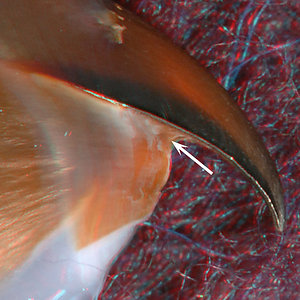 | 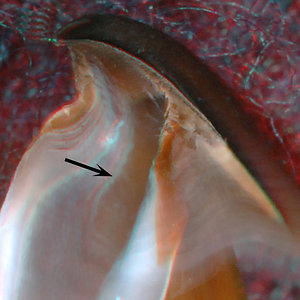 | 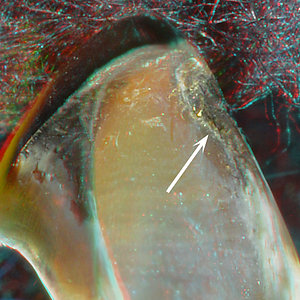 |
| Walvisteuthis youngorum, immature male, 57 mm ML, 2.7 mm URL. LEFT - Side view. MIDDLE - Oblique view. | Walvisteuthis virilis, mature male, 75 mm ML. Southeast Atlantic. | |
Walvisteuthis: LEFT - Immature squid. The anterior edge of the Shoulder Blade is S-shaped; its dorsal region (arrow) curves anteriorly. MIDDLE , arrow - Points to developing Palatoshoulder Ridge. RIGHT - Mature squid. In the fully pigmented beak, the Palatoshoulder Ridge (arrow) is fused to the Shoulder Blade but a thin superficial residue of the Hyaline Matrix lies on the surface between them. Note that the anterior end of the Ridge, at the arrow, is distinctly posterior to the anterior edge of the Shoulder Blade.
ONYKIA
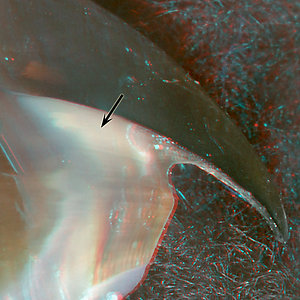 | 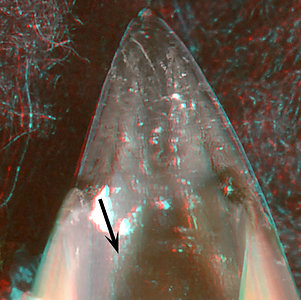 | 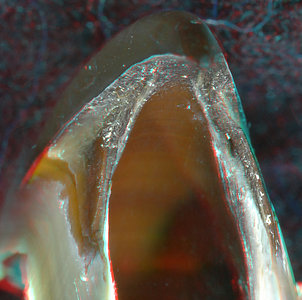 |
| Onykia robsoni, male, 162 mm ML, 5.3 mm URL. LEFT - Oblique view. | O. robsoni, mature male, 304 mm ML, 8.5 mm URL. RIGHT - Oblique view. | |
Onykia robsoni. LEFT - Presumed immature squid. The Outer Cover of the S-shaped Shoulder Blade is mostly a white translucent layer that is thickest dorsally (arrow). MIDDLE - The Palatoshoulder Ridge is in an early stage of development (arrow); the Hyaline Matrix lies between it and the Shoulder Blade (it looks grey in the photo); a typical Step can also be seen. RIGHT - Mature squid. The Hyaline Matrix remnant is more apparent than in the mature Walvisteuthis above. The Shoulder Blade has a distinct S-shaped curve even in this anterior view. Note that the Palatoshoulder Ridges on the Palate are broadly separated giving most to the Palate a broad, smooth, slightly concave surface in contrast to mature Onychoteuthis.
NOTONYKIA
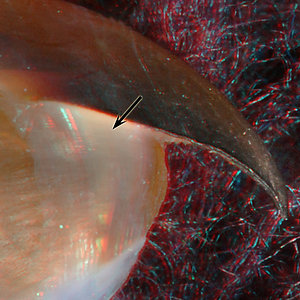 | 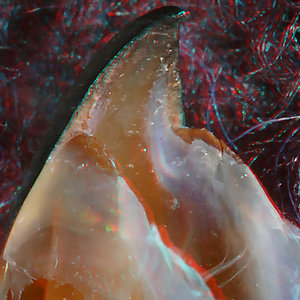 | 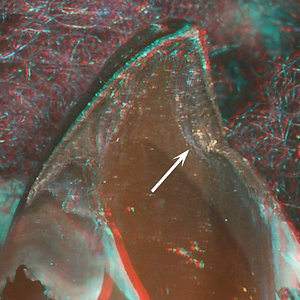 |
| Notonykia nesisi, female, 105 mm ML, 2.2 mm URL. LEFT - Oblique view. | N. africanae, female, 177 mm ML, 2.5 mm URL. RIGHT - Oblique view. | |
Notonykia: LEFT - Young female. The "S"-shape of the Shoulder Blade is not very apparent as the dorsal part of its profile turns sharply in an anterior direction. (This appears to be variable within the species.) The beak has a very large thick Shoulder Blade that has a typical Outer Cover with a yellow/white translucent pigment, thickest dorsally (arrow). MIDDLE - Young female. A developing Palatoshoulder Ridge lies medial to a large, white Hyaline Matrix. A Step is a bit difficult to recognize due to the small dorsal extension of the Shoulder Blade on the Palate. RIGHT - Large N. africanae. A heavily pigmented beak has a typical S-shaped anterior edge to the Shoulder Blade. The Shoulder Blade has a sharp medial edge which appears to be the result of wear making the Palatoshoulder Ridge difficult to recognize. The Ridge, however, is clear anteriorly (arrow) where is it defined by the thin white superficial layer of Hyaline Matrix between it and the Shoulder Blade.
FILIPPOVIA
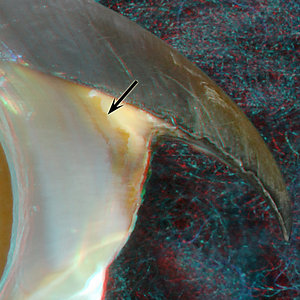 |  | 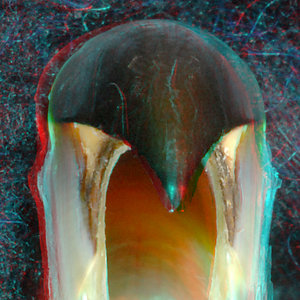 |
| Filippovia knipovitchi, immature female, 235 mm ML, 8.0 mm URL. LEFT - Side view. MIDDLE - Oblique view. RIGHT - Front view. | ||
Filippovia: LEFT - The profile of the S-shaped Shoulder Blade has a nearly flat convex portion. A thin amber-colored layer seems to be embedded within the Outer Cover (arrow). A similar layer can be recognized in the mature Onykia robsoni (far above). The significance of this, if any, is unknown. Otherwise this is a normal Tripartite beak. MIDDLE - The Palatoshoulder Ridge is well developed (arrow). The white area in this image (seen in advance of the arrow) appears to be an interface to the pigmented posterior end of the Hyaline Matrix (see the dark areas at either end of the white area). The white area is seen through the more typical, clear but slightly yellowish Hyaline Matrix. RIGHT - The upper, concave portion of the Shoulder Blade gradually curves medially (Right) rather than abruptly as seen in Walvisteuthis.
UPPER BEAK CHARACTERISTICS
A fourth genus, Lampadioteuthis, is placed in its own subfamily and does not have a Tripartite upper beak (see: 3° Unipartite Beak page and Survey of Unipartite Beaks page). No appropriately-sized beaks were available to cut.
LYCOTEUTHIS
 | 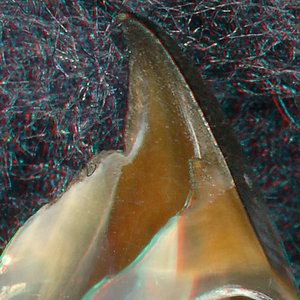 | 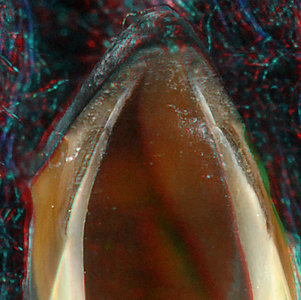 |
| Lycoteuthis lorigera, immature female, 72 mm ML, 3.2 mm URL. LEFT - Side view. MIDDLE - Oblique view. RIGHT - Front-oral view. | ||
Lycoteuthis: LEFT -The concave upper portion of the Shoulder Blade has a sharp bend (arrow). (This appears to be variable within the species.) There is no whitish/yellowish pigment concentrated dorsally within the Outer Cover of the Shoulder Blade. MIDDLE - The Palatoshoulder Ridge is typical but offset anteriorly only narrowly by the Hyaline Matrix. The Outer Cover seems to have a thin layer over it that could be a remnant of a true Shoulder Blade. RIGHT - The Shoulder Blade appears thinner than that of onychoteuthids. The Step is most apparent in this image.
NEMATOLAMPAS
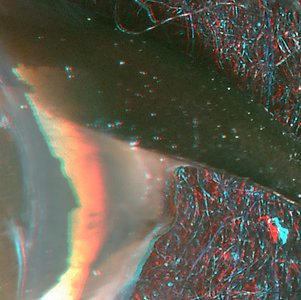 | 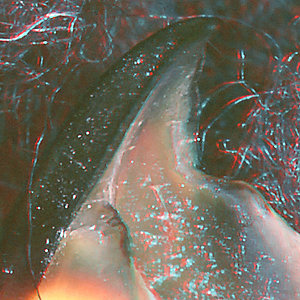 |  |
| Nematolampas venezuelensis, immature male, 88 mm ML, 3.0 mm URL. RIGHT - Side view. MIDDLE - Oblique view. RIGHT - Oral view. | ||
Nemantolampas: LEFT - The anterior edge of the Shoulder Blade has an S-shape although the convex portion has a distinct angle. The Outer Layer has a only a slight yellow/white translucency. MIDDLE - The Palatoshoulder Ridge is recognizable but its margins are not all distinct; anteriorly it lies close to the edge of the Shoulder Blade and is separated from the Shoulder Blade by only a narrow Hyaline Matrix. (The large size of the Palatoshoulder Ridge may partially be an effect of the rather advanced stage of the beak) RIGHT - A distinct Step is best seen in this image.
SELENOTEUTHIS
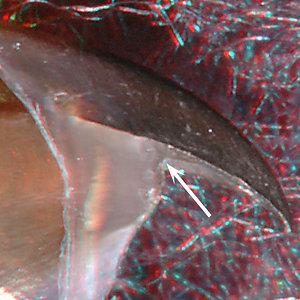 | 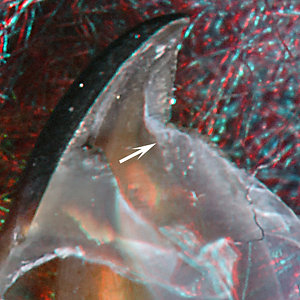 |  |
| Selenoteuthis scintillans, immature male, 24 mm ML, 1.2 mm URL. LEFT - Front-oblique view. | S. scintillans, mature female, 45 mm ML, 1.8 mm URL. RIGHT - Oblique view. | |
Selenoteuthis: The small size and rough surface of the beak make the Shoulder type difficult to recognize. LEFT - The anterior edge of the Shoulder Blade has an S-shape profile with a typical, dorsal concave portion (arrow). MIDDLE - The Outer Cover has a yellow/white translucency. A step is present but difficult to recognize. The Palatoshoulder Ridge is present (arrow) but, also, not easily recognized and is closely applied to the Shoulder Blade as the Hyaline Matrix has begun to sclerotize. RIGHT - The beak of this large and heavily pigmented female has a very rough surface and most details of the Shoulder structure have been lost; the beak type is difficult or impossible to identify.
UPPER BEAK CHARACTERISTICS
UPPER BEAK CHARACTERISTICS
Within the Enoploteuthidae, the Tripartite beak is most easily recognized in Enoploteuthis spp., due to their generally larger size. In the other genera the beak must be in very good condition and examination must be very careful to recognize the characteristic features of the Tripartite beak.
ENOPLOTEUTHIS (ENOPLOTEUTHIS)
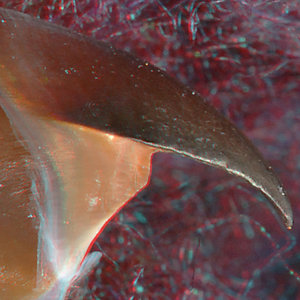 |  | |
| Enoploteuthis higginsi, mature male, 54 mm ML, 2.5 URL. LEFT - Side view. MIDDLE - Oral-front view. | E. jonesi, male, 58 mm ML, 3.2 mm URL. RIGHT - Front-oblique view. | |
Enoploteuthis (Enoploteuthis): LEFT - The S-shaped profile of the Shoulder Blade is apparent although the angles are rather sharp. The Outer Cover of the Shoulder Blade is not very distinct; it has no whitish/yellowish pigment concentrated dorsally. MIDDLE - The Palatoshoulder Ridge and the Hyaline Matrix are distinct on the right Shoulder, but on the left Shoulder part of the Hyaline Matrix has become sclerotized which makes the structures less recognizable. RIGHT - The beak is heavily pigmented. The Outer Cover of the Shoulder Blade is distinct; the Palatoshoulder Ridge can still be recognized as can the medial curvature of the Shoulder Blade, but only a trace remains of the Hyaline Matrix.
ENOPLOTEUTHIS (PARAENOPLOTEUTHIS)
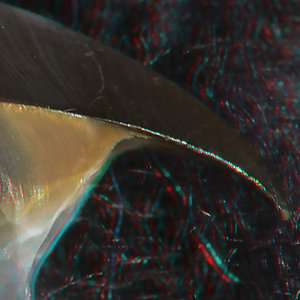 | 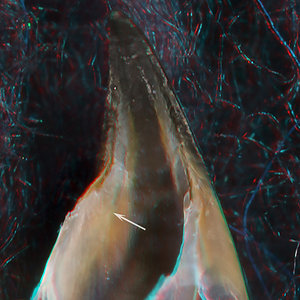 |  |
| Enoploteuthis reticulata, immature female, 51 mm ML, 3.1 mm URL. LEFT - Oral view. MIDDLE - Oblique view. Right - Posterior view. | ||
Enoploteuthis (Paraenoploteuthis): Members of this subgenus have narrower beaks. LEFT = The S-shaped profile of the Shoulder Blade can barely be recognized. The Outer Cover is the same as in the other subgenus. MIDDLE - The Shoulder Blade is very thin; the Palatoshoulder Ridge is difficult to follow as it submerges into the Hyaline Matrix (arrow) then gradually disappears; the Step, howwever, is clearly seen. RIGHT - The posterior view of the pigmented shoulder shows the "leaf shape" (arrow) which is characteristic of Tripartite beaks.
ABRALIA
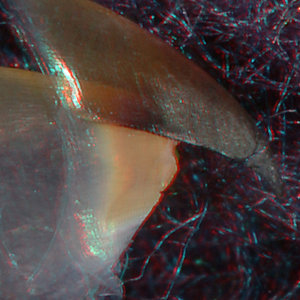 | 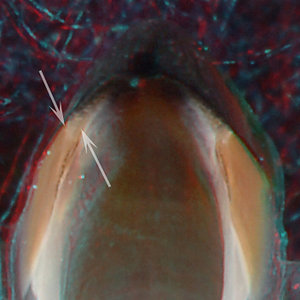 | 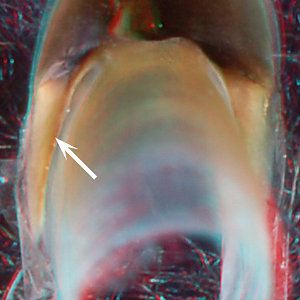 |
| Abralia astrosticta, immature female, 48 mm ML, 1.2 mm URL. LEFT - Front-oral view. MIDDLE - Front view. | ||
Abralia: Immature female. LEFT - The S-shaped profile of the Shoulder Blade can barely be recognized and the Outer Cover is hardly detected. MIDDLE - In this image the Outer Cover can be detected (upper arrow) and the Shoulder Blade bends medially (lower arrow) onto the Palate and creates a visible Step. RIGHT - The posterior view of the Shoulder shows the characteristic "leaf-shaped" pigmentation (arrow).
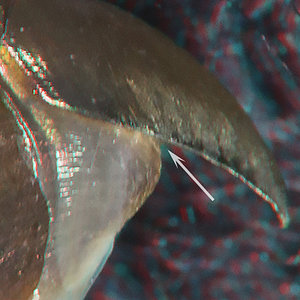 | 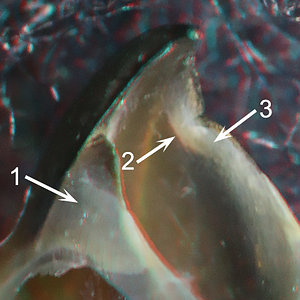 | 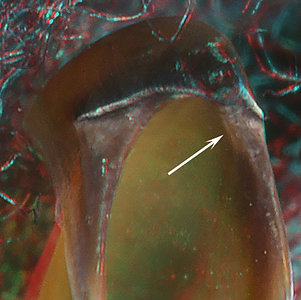 |
| Abralia trigonura, mature female, 33 mm ML, 1.2 mm URL. LEFT - Side view. MIDDLE - Oblique view. | A. trigonura, ? mm ML, 1.6 mm URL. Oblique-front view. | |
Abralia: LEFT - The upper, concave region of the S-shaped profile of the Shoulder Blade is present if you look very closely (arrow). Middle - The thick Shoulder Blade and its Outer Cover (1) are distinct as is the Hyaline Matrix (3). Only the anterior portion of the Palatoshoulder Ridge (2) remains. Right: In this particular fully pigmented beak, a trace of the anterior Palatoshoulder Ridge can barely be seen. In most such beaks no features other than the presence of a Step will be detectable. Note that the dorsoanterior end of the Outer Cover coincides with the beginning of the Step, making it indistinguishable, in this respect, from a fully pigmented Bipartitie beak of the same size.
ABRALIOPSIS
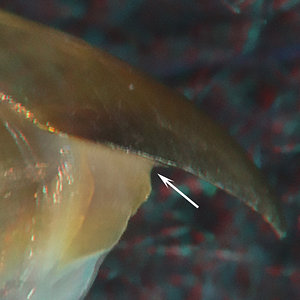 | 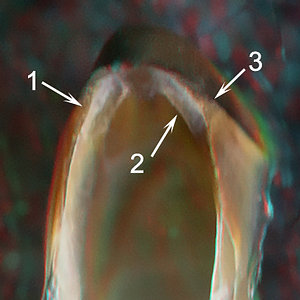 | 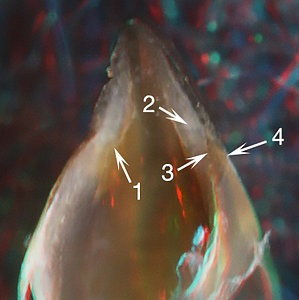 |
| Abraliopsis sp. A, immature female, 25 mm ML, 1.1 mm URL. MIDDLE - Oblique view. | Abraliopsis sp. A, just mature female, 27 mm ML, 1.2 mm URL. RIGHT - Oral-oblique view. | |
Abraliopsis: In the relatively small beaks, near or just at sexual maturity, the Tripartite beak features can often be recognized. LEFT - Immature female. The S-shaped anterior profile of the Shoulder Blade is easily seen. MIDDLE - Same beak. The medial curvature of the dorsal portion of the Shoulder Blade (1), the Step formed by this curvature (3) and the Palatoshoulder Ridge (2) are recognizable. RIGHT - Just mature female. All the typical features can be seen: Palatoshoulder Ridge (1), Hyaline Matrix (2), Shoulder Blade with a narrow extension onto the Palate (3) and its associated Step, and the anterior edge of the Outer Cover (4) of the Shoulder Blade.
 | 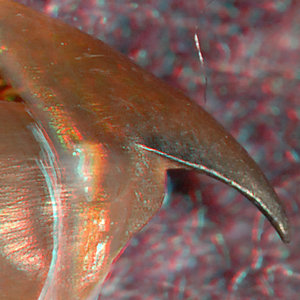 | 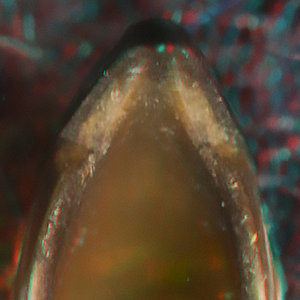 |
| Abraliopsis sp. A, mature female, 32 mm ML, 1.3 mm URL. RIGHT - Front-oral view. | Abraliopsis sp. A, mature female, 45 mm ML, 1.7 mm URL. MIDDLE - Side view. RIGHT - Front-oral view. | |
Abraliopsis: A large, fully mature female. LEFT - Appears similar to beak above; all the features noted above can be identified. MIDDLE - Mature female near maximum size. The S-shaped anterior profile of the Shoulder Blade is distinct. RIGHT - Same beak. The mid-Shoulder forms a thick rounded structure; the Shoulder Blade and the Palatoshoulder Ridge cannot be distinguished and the peculiar Tripartite relationship of the Shoulder Blade to the Palate cannot be unambiguously determined. Recognition of the beak type in fully pigmented beaks of many species is a problem but it is especially so in enoploteuthids; their abundance and, often, small adult size results in this terminal beak stage encountered more frequently in stomach contents.
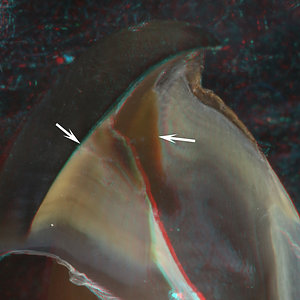
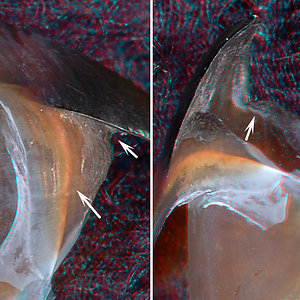
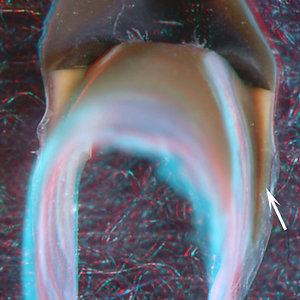


 Go to quick links
Go to quick search
Go to navigation for this section of the ToL site
Go to detailed links for the ToL site
Go to quick links
Go to quick search
Go to navigation for this section of the ToL site
Go to detailed links for the ToL site